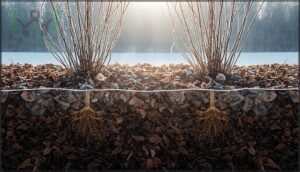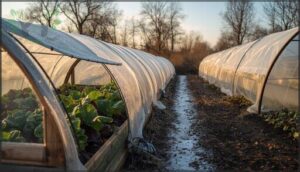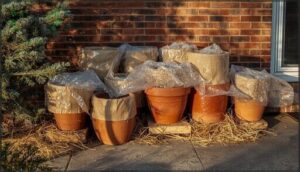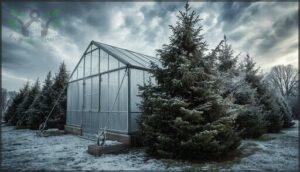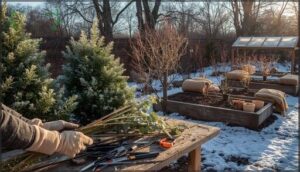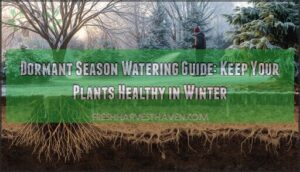This site is supported by our readers. We may earn a commission, at no cost to you, if you purchase through links.
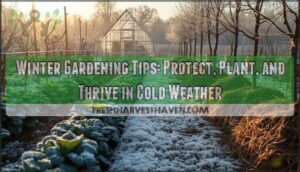
Cold weather doesn’t mean abandoning your outdoor space; it means adapting your approach. Strategic winter care protects your investment, extends your growing season, and sets the foundation for healthier plants year-round.
From insulating vulnerable roots to selecting species that thrive in freezing temperatures, winter gardening requires different techniques but delivers rewards that casual gardeners often miss.
Table Of Contents
- Key Takeaways
- Preparing Your Garden for Winter
- Choosing Cold-Hardy and Winter-Interest Plants
- Protecting Plants From Frost and Cold
- Winter Gardening Techniques and Care
- Enhancing Winter Garden Beauty and Function
- Frequently Asked Questions (FAQs)
- What to do in a garden in winter?
- What are winter garden tips?
- How can I make the most of winter in the garden?
- What can I do if I don’t have a garden this winter?
- How to maintain a garden in winter?
- How do I choose a Winter Garden?
- What should I be doing in my garden in winter?
- When should I start my winter garden?
- Are you supposed to cut back plants for winter?
- What is the best thing to plant in the winter?
- Conclusion
Key Takeaways
- Winter garden care directly determines spring success through strategic mulching, selective pruning, and protecting vulnerable roots before the first hard frost—with mulched beds maintaining soil temperatures up to 10°F warmer than bare ground.
- Cold-hardy plant selection extends your garden’s visual interest and functionality year-round, combining evergreens for structure, winter-blooming bulbs like hellebores and crocus, and native plantings that provide critical wildlife habitat when food sources are scarce.
- Container plants face severe winter risk with exposed roots freezing 75% faster than in-ground plantings, but wrapping pots in insulation, grouping them together, and elevating them off concrete can boost survival rates to 80-90%.
- Adjusting care routines for dormancy—reducing watering frequency by half, pruning trees between December and March to cut stress by 60%, and managing overwintering pests with targeted treatments—keeps your garden healthy through cold months while reducing spring workload.
Preparing Your Garden for Winter
Getting your garden ready for winter doesn’t have to feel overwhelming, but it does require a few important steps to protect your plants and set yourself up for success come spring. Think of it as tucking your garden in for a long rest—some plants need to come inside, others need extra protection, and your tools deserve a little care too.
Here’s what you need to focus on to prepare your garden before the cold truly settles in.
Reviewing and Organizing Plants
Before the season’s first frost locks in, take time to assess what worked and what didn’t. Seasonal adjustments start with plant recordkeeping—log what thrived, what struggled, and where each variety stood.
Sort seeds by viability, map your beds for spatial planning, and remove non-performers to free up space. This winter plant care step sets you up for stronger growth come spring.
Understanding seasonal plant needs is key for a thriving garden.
Moving Tender Plants Indoors
Once you’ve reviewed your winter garden, bringing plants indoors becomes your next priority. Move houseplants and tender specimens before nighttime temperatures drop below 45°F. Indoor acclimation works best when gradual—inspect for pests, trim damaged foliage, and adjust light requirements as you move them inside. Many plants suffer if there’s a sudden exposure to indoor environments.
Proper humidity control and pest prevention now make overwintering plants far easier, setting you up for a smooth spring shift outdoors.
Mulching and Insulating Garden Beds
After your plants settle indoors, turn your attention to mulching and insulating garden beds. A 2–4 inch mulch layer moderates soil temperature swings and improves moisture retention, boosting winter survival for perennials. Protecting plants from cold starts with smart soil insulation:
- Choose coarse materials like wood chips or shredded leaves as effective mulch materials
- Apply mulch depth carefully, avoiding plant crowns to prevent rot
- Wait until after the first hard frost for best timing
Proper insulation means healthier roots come spring.
Pruning and Garden Cleanup
Once your beds are insulated, tackle pruning and garden cleanup with strategic timing. Late winter pruning can increase flower counts by 20–35%, while removing dead branches reduces disease risk when pathogens are dormant.
Clear fallen leaves and plant debris to cut pest populations by up to 40%, but consider delaying cleanup until spring temperatures consistently top 50°F—protecting overwintering pollinators that shelter in stems and leaf litter.
Maintaining and Storing Gardening Tools
Before winter settles in, proper tool maintenance can double your equipment’s lifespan from five to ten years.
Clean and dry cutting tools thoroughly—removing soil cuts rust risk by 80%. Oil metal parts and wooden grips to reduce corrosion by 65%, then organize them on pegboards or wall racks in a dry shed.
Sharpening gardening tools now and implementing rust prevention saves you $36–$78 annually in replacement costs.
Choosing Cold-Hardy and Winter-Interest Plants
A thriving winter garden starts with choosing plants that can handle what the season throws at them. You’ll want a mix of hardy perennials, evergreens, and blooms that actually show up when temperatures drop.
Here’s how to select plants that won’t just survive winter—they’ll make your garden worth stepping outside for.
Selecting Cold-Tolerant Perennials and Annuals
Choosing the right plant material means understanding your Hardiness Zone and matching it to proven performers. Cold-hardy plants—perennials like hellebores and annuals such as pansies—offer considerable bloom longevity and winter survival when you select regionally adapted varieties.
Plant selection focused on winter color extends your garden’s beauty and delivers a major economic impact by reducing replanting costs and maintenance over time.
Incorporating Evergreens and Ornamental Grasses
If you want year-round garden structure and easy winter interest, evergreens and ornamental grasses are the workhorses you need. Evergreen hedges provide up to 40% sound buffering and visual screening, while grasses like miscanthus add texture, movement, and bronze winter hues.
Both offer outstanding maintenance longevity and wildlife support, requiring minimal input once established, making winter landscaping both practical and beautiful.
Planting Winter-Blooming Bulbs and Flowers
You can brighten the coldest months by planting snowdrops, crocus, and hellebores now—bulbs that deliver reliable winter blooms.
Plant them 8–12 cm deep in well-drained soil six to eight weeks before the ground freezes, ensuring proper bulb chilling needs are met for suitable planting depth and bloom time extension.
These winter flower varieties reward you with color when little else dares to show, proving soil drainage importance prevents rot and fosters lasting winter blooms.
Creating Wildlife-Friendly Spaces
Your garden can serve as a sanctuary for local wildlife through the coldest months. By integrating native plantings and shelter creation, you actively support garden wildlife year-round. Consider these steps for providing wildlife habitat:
- Plant winterberry and native shrubs that offer food and cover
- Install bird feeders with high-fat seeds for winter energy
- Maintain unfrozen water sources using heated birdbaths
- Build brush piles and leave leaf litter to increase habitat diversity
These sustainable practices transform your space into a thriving ecosystem.
Protecting Plants From Frost and Cold
When temperatures drop and frost threatens, your plants need more than luck—they need the right protection. A few practical strategies can shield roots, crowns, and containers from the worst of winter’s bite.
Here’s how to keep your garden safe through the cold months ahead.
Using Mulch for Root and Crown Protection
Mulch acts like a winter blanket for your garden, shielding roots and crowns from temperature swings and frost heaving.
Apply 4 to 6 inches of organic material—such as wood chips or shredded bark—after the first hard frost to protect plants while preventing root rot.
Keep mulch 2 to 3 inches from stems to promote air circulation and soil health.
Installing Row Covers, Cold Frames, and Low Tunnels
Row covers, cold frames, and low tunnels offer powerful temperature protection and pest exclusion while boosting yields. Heavyweight row covers shield crops down to 24°F, and low tunnels can raise temperatures by 12°F on frigid nights.
Install these cover materials in fall as freezing nights approach, securing spunbonded polyester or polypropylene fabric over hoops. Open tunnel ends during warmer daylight hours to prevent overheating.
Insulating Containers and Outdoor Pots
Container gardening faces unique challenges once the cold settles in. Exposed roots in outdoor pots freeze faster than in-ground plantings, with unprotected containers losing plants at rates exceeding 75% when temperatures dip below 23°F for a full day. Protecting container plants with proper insulation, strategic placement strategies, and smart application timing safeguards your investment.
Container plants face severe winter risk, with exposed roots freezing faster than ground plantings and unprotected pots losing over 75% of plants below 23°F
Five ways to winterize your outdoor plant protection:
- Wrap pots in bubble wrap or burlap – Two layers can cut heat loss by 20–30% and extend frost protection up to five extra days.
- Group containers together – Clustering pots on a building’s sheltered side reduces freeze losses by 35% compared to isolated placement.
- Choose the right pot material – Concrete and fiberglass planters offer 35–50% better insulation than terracotta, which cracks easily during freeze-thaw cycles.
- Add thick mulch layers – Straw, hay, or shredded leaves on top of the soil raise root temperatures by 3–5°C, cutting freeze damage considerably.
- Insulate before the first hard frost – Early wrapping, when soil temps drop near 45°F, doubles survival rates compared to late applications.
Insulation materials like rigid foam inside planters reduce soil temperature swings by up to 60%. Elevating pots a few inches off concrete improves insulation by 12%, and burying containers in mulch-filled trenches can push survival rates to 80–90% for moderately hardy species—effectively shifting you two hardiness zones warmer.
Securing Garden Structures Against Wind
While insulated pots protect roots, strong winds threaten the whole winter garden setup. An 80 mph gust creates 16 pounds per square foot of pressure—enough to flatten greenhouses or toss lightweight structures.
Wind load calculations guide your anchoring techniques: secure posts in concrete footings every 4–6 feet, add corner cables with turnbuckles, and plant windbreaks of dense conifers upwind.
Storm preparation means closing vents, removing loose debris, and choosing rounded designs with polycarbonate panels for excellent outdoor plant protection in cold weather.
Winter Gardening Techniques and Care
Winter isn’t just about protecting your garden—it’s also the perfect time to fine-tune your care routines and set yourself up for spring success.
From adjusting how much you water to tackling pruning tasks while plants rest, these techniques keep your garden healthy through the cold months.
Let’s walk through the key practices that’ll help your winter garden not just survive, but actually thrive.
Adjusting Watering Practices for Winter
Watering practices shift dramatically once winter arrives, with reduced frequency becoming the new normal. Evaporation rates drop by more than half, meaning your plants need far less moisture than during summer’s heat.
- Morning timing works best, reducing ice formation risk around roots by up to 30% compared to evening watering
- Moisture monitoring before each watering prevents the overwatering that causes 40% of winter root rot cases
- Container specifics matter since potted plants lose moisture twice as fast as in-ground specimens in freezing temperatures
- Deep watering before hard freezes can cut frost injury risk by 22% while keeping root zones warmer
Check soil moisture regularly—let it dry 1–2 inches down before watering again. This simple adjustment to your watering routine protects roots and aids healthier winter garden care overall.
Pruning Dormant Trees and Shrubs
Between December and late March, you can prune trees and shrubs with confidence, knowing dormant pruning techniques reduce stress by more than 60%. Remove up to 30% of live branches to improve structural integrity, eliminate disease risks, and promote faster wound closure—about 20-40% quicker than spring cuts.
This timing strengthens pruning dormant plants while supporting long-term outcomes like extended lifespan and healthier regrowth.
Managing Winter Pests and Diseases
When managing winter pests and disease development, don’t overlook survival strategies hidden beneath your mulch and soil. Aphid eggs endure temperatures as low as 5°F, while Colorado potato beetles hibernate up to 10 inches underground.
Apply IPM efficacy through winter treatments like borate sprays and biological controls—predatory mites and Bacillus thuringiensis target overwintering stages, reducing pest populations by spring without harming beneficial insects.
Extending The Growing Season With Greenhouses
Beyond insulation and pruning, greenhouse gardening transforms your winter garden into a year-round production space. Well-designed structures can extend your growing season by up to 67%, maintaining temperatures 30°F warmer than outside.
With proper temperature control and crop yield optimization, you’ll harvest fresh greens, herbs, and vegetables throughout winter.
While initial cost analysis shows construction averaging $33 per square foot, the market impact and greenhouse efficiency make indoor gardening worthwhile for serious growers.
Enhancing Winter Garden Beauty and Function
Winter doesn’t have to mean a dull, lifeless garden. With thoughtful design choices and a few strategic touches, you can transform your outdoor space into something that’s both visually striking and functionally sound, even during the coldest months.
Here’s how to bring beauty and purpose to your winter landscape.
Creating Focal Points With Evergreens and Structures
Your winter garden needs year-round structure, and evergreen textures paired with winter hardscape deliver exactly that. Position evergreens like boxwood or spruce near benches or sculptures to create focal points that anchor the eye.
Evergreen hedges define spaces while offering wildlife benefits—shelter and nesting sites—and moderating your garden microclimate. This pairing achieves visual cohesion even when deciduous plants rest.
Adding Lighting for Visual Interest
Lighting the winter garden transforms short days into evenings worth lingering in, and design techniques like uplighting evergreens or stringing solar lanterns along paths make cold-weather spaces inviting. You’ll find installation costs range from $650 to $2,250 for small systems, with these options balancing energy efficiency and lighting safety:
- LED spotlights for architectural features
- Pathway bollards preventing slips
- Smart systems with programmable schedules
- String lights creating ambient warmth
- Motion-activated security fixtures
Proper light levels extend your garden’s usability by over two hours nightly.
Decorating With Natural Elements and Containers
You can bring warmth to the coldest months by sourcing pine cones, twigs, and evergreen branches—over 60% of gardeners rely on these natural elements for winter displays.
Container arrangement themes take shape when you pair red-twig dogwood with ornamental kale in weather-resistant fiberglass or concrete pots, which boost root survival rates by 40%.
Eco-friendly ornamentation using biodegradable materials completes your winter garden design with both visual impact and sustainability.
Supporting Garden Wildlife Through Winter
Once you’ve added decorative touches, you can turn your attention to the creatures that call your garden home year-round.
Supporting garden wildlife starts with these essential steps:
- Set up bird feeders with high-fat seed blends—supplemental feeding boosts chickadee survival from 37% to 69% during extreme cold.
- Install heated bird baths to provide water access when natural sources freeze.
- Build brush piles from fallen branches for shelter structures.
- Leave native flower stalks standing for insect support.
- Plant berry-producing native habitats like holly and viburnum.
These practices create ecosystem support that extends well beyond winter, enriching your garden’s ecological value.
Frequently Asked Questions (FAQs)
What to do in a garden in winter?
Dormant doesn’t mean dead—your garden still demands attention during the coldest months. Winter gardening involves protecting plants, preparing beds, planting cold-weather crops, and supporting wildlife, all while maintaining seasonal garden design and soil health year-round.
What are winter garden tips?
Winter garden tips focus on protecting plants during winter, selecting cold-hardy veggies, preparing plants for winter with mulch, and practicing sustainable container plant care.
Frost damage control and proper winter soil prep guarantee successful cold weather gardening.
How can I make the most of winter in the garden?
You can increase winter yields by choosing cold-season edibles, using year-round gardening strategies, and improving winter garden design.
Preparing plants for winter and proper plant protection help ensure that cold weather doesn’t stop your horticultural success.
What can I do if I don’t have a garden this winter?
You can explore indoor gardening through container plants and vertical systems on balconies or windowsills.
Hydroponics benefits include efficient houseplant care and faster growth, transforming any space into a productive houseplant garden.
How to maintain a garden in winter?
As the saying goes, “A stitch in time saves nine.” Maintaining your winter garden means adjusting cold weather watering, addressing winter pest control, completing winter garden cleanup, protecting dormant plant care needs, and storing tools properly—essential winter garden maintenance chores.
How do I choose a Winter Garden?
Choosing your winter garden starts with climate considerations and soil assessment. Evaluate available space, then focus on plant selection for winter interest—think evergreens for structure, colorful berries, and fragrant bloomers. Budget planning helps prioritize purchases wisely.
What should I be doing in my garden in winter?
Think of winter as your garden’s quiet season, not its end.
Your cold-season gardening jobs include pruning dormant plants, mulching beds, protecting tender specimens, maintaining tools, and planning next year’s layout—essential off-season garden care.
When should I start my winter garden?
Your planting season depends on regional timing and first frost dates.
In warmer zones, start preparing plants for winter in late summer; colder regions should begin by early fall, considering microclimates.
Are you supposed to cut back plants for winter?
Winter pruning benefits some plants, but timing matters. Prune dead branches and dormant plant material carefully—frost damage risks increase with poor timing.
Meanwhile, winter foliage insulation and seedhead food sources support wildlife when you skip cutting back certain perennials.
What is the best thing to plant in the winter?
The coldest months can yield the warmest rewards if you plant cold-hardy vegetables like spinach and kale, winter-blooming flowers such as hellebores, evergreen shrubs, groundcovers, and wet-soil plants for winter color and fragrance.
Conclusion
Studies show that mulched garden beds can maintain soil temperatures up to 10 degrees warmer than bare ground—a difference that often determines whether roots survive or fail.
Your winter gardening tips don’t just preserve plants; they actively improve soil structure, reduce spring workload, and create habitat when wildlife needs it most.
The gardeners who treat winter as preparation rather than pause consistently see stronger growth, fewer losses, and gardens that rebound faster when warmth returns.
- https://www.finegardening.com/project-guides/fruits-and-vegetables/cold-frame-gardening
- https://www.insongreen.com/keep-greenhouse-warm-in-winter/
- https://www.veikous.com/blogs/news/how-to-keep-a-greenhouse-warm-in-the-winter
- https://www.accio.com/business/live_trends_winter_garden
- https://www.johnnyseeds.com/growers-library/methods-tools-supplies/winter-growing-season-extension/winter-growing-guide-recommended-crops-varieties.html


